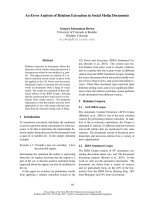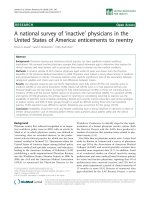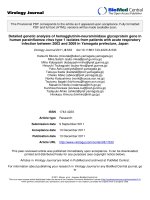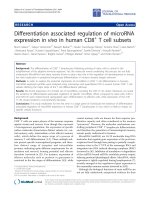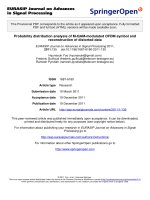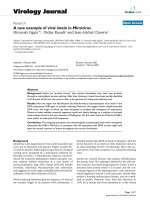Báo cáo sinh học: "Bayesian segregation analysis of milk flow in Swiss dairy cattle using Gibbs sampling" pdf
Bạn đang xem bản rút gọn của tài liệu. Xem và tải ngay bản đầy đủ của tài liệu tại đây (461.14 KB, 14 trang )
Genet. Sel. Evol. 36 (2004) 563–576 563
c
INRA, EDP Sciences, 2004
DOI: 10.1051/gse:2004017
Original article
Bayesian segregation analysis of milk flow
in Swiss dairy cattle using Gibbs sampling
Houcine I
∗
,HajaN.K
Statistical Animal Genetics Group, Institute of Animal Sciences, Swiss Federal Institute
of Technology, ETH-Zentrum, Universitätsstrasse 65, 8092 Zurich, Switzerland
(Received 16 February 2004; accepted 21 May 2004)
Abstract – Segregation analyses with Gibbs sampling were applied to investigate the mode
of inheritance and to estimate the genetic parameters of milk flow of Swiss dairy cattle. The
data consisted of 20 4397, 655 989 and 40 242 lactation records of milk flow in Brown Swiss,
Simmental and Holstein cattle, respectively (4 to 22 years). Separate genetic analyses of first
and multiple lactations were carried out for each breed. The results show that genetic parameters
especially polygenic variance and heritability of milk flow in the first lactation were very similar
under both mixed inheritance (polygenes + major gene) and polygenic models. Segregation
analyses yielded very low major gene variances which favour the polygenic determinism of milk
flow. Heritabilities and repeatabilities of milk flow in both Brown Swiss and Simmental were
high (0.44 to 0.48 and 0.54 to 0.59, respectively). The heritability of milk flow based on scores
of milking ability in Holstein was intermediate (0.25). Variance components and heritabilities
in the first lactation were slightly larger than those estimates for multiple lactations. The results
suggest that milk flow (the quantity of milk per minute of milking) is a relevant measurement
to characterise the cows milking ability which is a good candidate trait to be evaluated for a
possible inclusion in the selection objectives in dairy cattle.
segregation analysis / Bayesian method / major gene / milk flow / Swiss cattle
1. INTRODUCTION
In dairy cattle, yields of milk and milk solids are of primary economic con-
cern; however other traits, particularly milking ability (milk flow or milking
time), longevity, disease resistance and reproductive efficiency are also of eco-
nomic importance. An increase in milk flow is associated with a decrease in
milking labour time, which significantly reduces the cost of milking via less
electrical power and wear and tear of milking equipments.
In livestock populations, large volumes of phenotypic observations are of-
ten available at low costs and it is worthwhile to use them to look for statistical
∗
Corresponding author:
564 H. Ilahi, H.N. Kadarmideen
evidence of major genes or quantitative trait loci (QTL) by statistical analysis.
Segregation analysis is the most powerful statistical method to identify a single
gene when DNA marker information is unavailable. With segregation analysis,
it is possible to determine, using only phenotypic data, whether the inheritance
of a certain trait is controlled, at least in part, by a single gene with a large
effect. Therefore, segregation analysis (e.g. [6] and [12]) could be performed
to investigate the evidence of the presence of major genes and to determine
whether costly genotyping of large numbers of animals for many DNA mark-
ers could be justified. In dairy goats, a major gene explaining about 60% of
the total genetic variance of milk flow has been shown [7, 13]. As mentioned
earlier, milk flow is also an economically important trait in dairy cattle. There-
fore, it would be useful to investigate if evidence of a major gene for milk flow
in dairy cattle exists, similar to dairy goats. Furthermore, genetic parameters
for milk flow have never been estimated for Swiss dairy cattle.
In a typical segregation analysis using pedigreed animal populations, com-
plexity brought-in by the existence of many (inbreeding) loops makes the exact
computations of marginal densities impossible. This problem has been sim-
plified by the development of Gibbs sampling, a Monte Carlo Markov chain
(MCMC) methodology [5] and the application of this methodology to livestock
populations [19] and [8].
The main objectives of this study were to estimate genetic parameters of
milk flow, and to investigate whether a segregating major gene affecting milk
flow exists in three breeds of Swiss dairy cattle, using 4 to 22 years of milk
flow data. A Bayesian segregation analysis using the Gibbs sampling method
and a restricted maximum likelihood method were applied to achieve these
objectives.
2. MATERIALS AND METHODS
2.1. Data
The data available for this study consisted of the milk flow records of
the three major dairy breeds in Switzerland (Brown Swiss, Simmental and
Holstein). For both Brown Swiss and Simmental, the milking ability of a cow
was measured as the quantity of milk in kg per minute of milking either in
the morning or evening milking and only one milking was considered for the
measurement, mostly during the first lactation. The cows measured for milk
flow in later lactations were not selected and this depended on the breeders.
Some breeders, who were not satisfied by the measurement of milk flow for a
Inference of major gene for milk flow in cattle 565
certain number of cows in the first lactation, repeated the test in second or later
lactations. Other breeders measured the milk flow for the whole population in
first and later lactations. For Holstein, based on the farmers information of the
cows milking abilities, 15 classifiers attributed a score on the scale of 1 to 5 for
milk flow of each cow: 1=very slow, 2=slow, 3=average, 4=fast and 5=very
fast. Datasets from each breed were edited such that only herds that had at least
10 lactation records were included in the analyses.
Brown Swiss: two data sets on milk flow corresponding to the first and multiple
lactations recorded for 22 years between 1980 and 2002 were obtained. After
editing on the herd size (≥10 records), there were 169 503 records from the
first lactation, and 204 397 records from multiple lactations (first, second, third
and later lactations).
Simmental: data sets on the milk flow of the first lactation and multiple lac-
tations recorded for 22 years between 1980 and 2002 were obtained. After
editing on the herd size (≥10 records), there were 621 376 records from the
first lactation, and 655 989 records from multiple lactations (first, second, third
and later lactations).
Holstein: milk flow scores measured for 4 years between 1999 and 2003 were
collected. There were no sufficient records on second or later lactations to carry
out analysis for multiple lactations. Therefore, only data from first lactations
were retained and edited on the herd size (≥10 records). The final data set
consisted of 40 242 from first lactation records.
For each breed and data set, all the pedigrees were traced as far back as pos-
sible for fitting (mixed inheritance and polygenic) individual animal model.
The description of different data sets and pedigrees for all breeds in first lacta-
tion (FL) and multiple lactations (ML) are given in Table I.
2.2. Genetic models
2.2.1. Mixed inheritance model
A mixed inheritance model with fixed effects (non-genetic effects), random
effects of polygenes, and the fixed effect of a single major gene were used to
investigate the presence of a major gene in inheritance of milk flow.
The mixed inheritance models for first lactation and multiple lactation data
sets for all three breeds are described as:
First lactation:
y = Xβ + Zu + ZWm + e (1)
566 H. Ilahi, H.N. Kadarmideen
Table I. Description of different data sets and pedigrees for all breeds in first lactation
(FL) and multiple lactations (ML).
Breed Brown Swiss Simmental Holstein
∗
Number of levels FL ML FL ML
Herd 6837 7645 13 141 13 461 1791
Year-season 96 96 95 95 18
Parity - 3 - 3 -
Lactation stage 9 9 9 9 9
Breed - - 6 6 -
Season-classifier - - - - 29
Animal in pedigree 343 969 377 453 991 983 1 013 610 117 136
∗
Only first lactation was used.
Multiple lactations:
y = Xβ + Zu + Qpe + ZWm + e (2)
where y is the vector of observations, β is a vector of non-genetic fixed effects
(Brown Swiss data: herd, year-season, parity, stage of lactation; Simmental
data: herd, year-season, parity, breed, stage of lactation; Holstein data: herd,
year-season, season-classifier, stage of lactation), u is a random vector of poly-
genic effects, pe is a random vector of permanent environmental effects, W is a
matrix containing the genotype of each individual, m is the vector of genotype
means, e is a random vector of residual effects, and X, Z and Q are incidence
matrices relating the observations to their respective effects. For the Simmental
breed association, the population consisted of crossbred animals of Simmental,
Holstein and Montbéliarde breeds. The animals were then allotted to 6 breeds
or sections according to their blood percentage and color.
A description of different data sets (the number of levels of all effects in-
cluded in the model) and the number of animals in the pedigrees of all the
breeds are given in Table I.
The major gene was modelled as an autosomal biallelic (A and B) locus
with Mendelian transmission probabilities. Allele A is defined to decrease the
phenotypic value, and allele B is defined to increase the phenotypic value. In
the presence of two alleles A and B, with frequencies p and q = 1 − p,where
p is the estimate of A allele frequency in the founder population in which
the Hardy-Weinberg equilibrium was assumed, three genotypes AA, AB or BA
and BB can be encountered, with genotype means m
= (−a, d, a), where a is
referred to as the additive effect and d is referred to as the dominant effect at
the major locus.
Inference of major gene for milk flow in cattle 567
Distributional assumptions for polygenic effects were, u ∼ N(0, Aσ
2
u
),
where A is the numerator relationship matrix. The distribution of the per-
manent environmental effects were, pe ∼ N(0, Iσ
2
pe
). Residual effects were
assumed to be distributed as e ∼ N(0, Iσ
2
e
). σ
2
u
, σ
2
pe
and σ
2
e
are polygenic, per-
manent environmental and residual variances, respectively. The relationship
matrix of the full pedigree A was used in the analyses.
Uniform prior distributions were assumed in the range (−∞, +∞) for non-
genetic effects and effects at the major locus, in the range (0, +∞) for variance
components, and in the range [0, 1] for allele frequencies [8].
Gibbs sampling algorithm with blocked sampling of genotypes was used for
inference in the mixed inheritance models (1) and (2) and implemented using
the MAGGIC software package developed by Janss [10].
Twenty replicates of Gibbs chains of 100 000 cycles were run for each anal-
ysis, using a spacing of 50 cycles, obtaining 2000 Gibbs samples per chain and
40 000 samples in total for each analysis. A burn-in period of 1000 cycles was
used to allow the Gibbs chains to reach equilibrium.
Marginal posterior densities of the following parameters were directly esti-
mated in each Gibbs cycle (variance components σ
2
u
, σ
2
pe
and σ
2
e
, additive and
dominance effects at the major gene a and d, and allele frequency p). These
parameters allowed the computation, in each Gibbs cycle, of the heritability,
h
2
= σ
2
u
/(σ
2
u
+ σ
2
pe
+ σ
2
e
), repeatability, r = (σ
2
u
+ σ
2
pe
)/(σ
2
u
+ σ
2
pe
+ σ
2
e
)andthe
genotypic variance due to the major gene, σ
2
m
= 2pq[a + d(p − q)]
2
+ (2pqd)
2
as given in [4].
2.2.2. Polygenic model
The aim of fitting a polygenic model to first lactation data sets of three
breeds was to obtain genetic parameter estimates of milk flow and to compare
them with those obtained using the mixed inheritance model (to check the
mode of inheritance of this trait).
Therefore, only the first lactation data sets of three breeds were analysed to
estimate the genetic parameters by a restricted maximum likelihood method-
ology (REML) by an individual animal model, using VCE software [16]. The
model used was a sub-model of (1) and specified as, y = Xβ + Zu + e, with
all the model terms the same as defined in model (1). The parameters of inter-
est for statistical inferences in this polygenic model were residual variance, σ
2
e
polygenic variance, σ
2
u
and heritability, h
2
= σ
2
u
/(σ
2
u
+ σ
2
e
).
568 H. Ilahi, H.N. Kadarmideen
3. RESULTS AND DISCUSSION
3.1. Trait distributions
Table II represents lactation-wise (1, 2 and 3+ lactations) means and stan-
dard deviations of milk flow for all breeds. The observed means for milk flow
in both Brown Swiss and Simmental were higher in first lactation than later
lactations which is in line with the findings of Dodenhoff et al. [3]. The mean
milk flow was slightly higher in Brown Swiss than in Simmental. The distri-
bution of Holstein milk flow score for the first lactations is plotted in Figure 1,
which shows that a milk flow score of 3 was more frequent and presented more
than 60% of the total data.
3.2. Polygenic model
The genetic parameters estimated by REML for milk flow in the first lacta-
tion and for the three breeds are presented in Table III.
The heritability of milk flow was high and very similar for Brown Swiss
and Simmental breeds (0.46 and 0.48). In Holstein, milk flow score had an
intermediate heritability (0.25). This is explained by the differences in scale
on which milk flow of a cow was measured: in Brown Swiss and Simmental
breeds, the milk flow was measured as the quantity of milk in kg per minute
of milking (on a continuous scale) whereas, in Holstein the milk flow of a
cow was a score trait, scored from 1 to 5. Genetic variance of discrete traits is
usually lower in magnitude than those for continuous traits due to the loss of
information when (continuous) data is truncated to a few classes or categories
(e.g. Kadarmideen et al. [11]). This loss of information is true even for major
gene and QTL effects on a continuous versus discrete (probability) scale [11].
The estimated heritability of milk flow for Brown Swiss and Simmental
(0.46), was higher than the heritabilities reported by Sprengel et al. [20].
For Holstein, the heritability of milk flow score (0.25) was in accordance
with other studies based on similar subjectively scored milk flow measure-
ments [2, 14, 17].
3.3. Mixed inheritance model
Posterior means and standard deviations of parameter estimates of milk flow
using Bayesian segregation analyses implemented by Gibbs sampling are pre-
sented in Tables IV and V for the first and multiple lactations, respectively.
Inference of major gene for milk flow in cattle 569
Figure 1. Histogram of milk flow score of Holstein based on 40 242 first lactation
records.
Table II. Number of observations, means, and standard deviations of milk flow of
Brown Swiss and Simmental for lactations 1, 2, 3 and more and for first lactation
records of Holstein.
Parity 1st 2nd 3rd and more
Breed
N 175850 21 205 7342
Brown Swiss Mean 2.763 2.626 2.676
SD 0.516 0.528 0.535
N 623953 22 336 9700
Simmental Mean 2.680 2.592 2.581
SD 0.545 0.592 0.588
N 40242 - -
Holstein
∗
Mean 3.12 (score) - -
SD 0.678 - -
∗
Milk flow was subjectively scored on a scale of 1 to 5.
These estimates are based on 40 000 Gibbs samples from twenty replicated
chains. Tests for convergence of the Gibbs sampler showed that Gibbs samples
of all the parameter estimates achieved a good stationary phase. For both anal-
yses (first and multiple lactations), the standard deviations of the marginal pos-
terior estimates were very small (Tabs. IV and V). As highlighted by Walling
et al. [21], since the convergence of a Gibbs chain is determined by mixing
570 H. Ilahi, H.N. Kadarmideen
Table III. Estimates of residual variance (σ
2
e
), polygenic variance (σ
2
u
) and heritability
(h
2
) with standard error in parentheses obtained by REML with the polygenic model
for milk flow for first lactation records in Brown Swiss and Simmental breeds, and
scored in Holstein breed.
Breed σ
2
e
σ
2
u
h
2
Brown Swiss 0.138 0.116 0.46 (0.005)
Simmental 0.143 0.130 0.48 (0.004)
Holstein
∗
0.333 0.111 0.25 (0.013)
∗
Milk flow was subjectively scored on a scale of 1 to 5.
properties of the parameters, large numbers of realisations were necessary to
provide sufficient independent samples to estimate the posterior distributions
of parameters. Miyake et al. [15] reported that increasing the number of Gibbs
samples is an effective way of improving the precision of estimated parameters
while precision also depends on the size of data. In this study, large numbers
of cycles were used to ensure proper mixing and improve the precision of esti-
mated parameters.
Estimated genetic parameters of milk flow (in the first lactation) obtained
by Bayesian segregation (mixed inheritance model) analyses were similar to
those obtained under the polygenic model by REML (Tabs. III and IV).
According to Box and Tiao [1], the posterior density regions (HPD), based
on a non-parametric density estimate using the averaged shifted histogram
technique [18], were obtained for all model parameters. These highest regions
were constructed to include the smallest possible region of each sampled pa-
rameter values. In all analyses, the highest posterior density regions at 95%
(HPD
95%
) of the additive effect (a) and of the dominance effect (d)atthema-
jor locus included zero (Tabs. IV and V). The allele frequencies p and q in the
three breeds were intermediate (0.47 to 0.51 and 0.53 to 0.49, respectively).
Furthermore, the estimates of major gene variance (σ
2
m
) ranged from 0.0009
to 0.0011. Janss et al. [9] and Miyake et al. [15] also suggested the use of the
magnitude of the major gene variances as an indicator for the existence of seg-
regating a major gene. These results suggest that the postulated single major
gene influencing milk flow has no significant effect and the higher heritability
of this trait may be due only to polygene effects. These results are, however,
in contrast to dairy goats where a major gene explaining about 60% of the
total genetic variance of milk flow [7, 13] was found. These differences in re-
sults could simply indicate that mixed inheritance of certain traits in livestock
is species-specific or that the identified major gene in goats has been fixed in
cattle.
Inference of major gene for milk flow in cattle 571
Table IV. Estimated marginal posterior means (mpm), marginal posterior standard deviations (mpsd) and highest posterior density
region at 95% (HPD
95%
) of parameters for milk flow in a mixed inheritance model (first lactation), based on 40 000 Gibbs samples from
20 replicated chains.
Breed Brown Swiss Simmental Holstein
∗
Parameters mpm mpsd HPD
95%
mpm mpsd HPD
95%
mpm mpsd HPD
95%
σ
2
e
0.137 0.001 0.134/0.139 0.154 0.000 0.152/0.155 0.334 0.006 0.321/0.347
σ
2
u
0.117 0.002 0.113/0.121 0.134 0.001 0.131/0.137 0.110 0.008 0.093/0.127
a 0.016 0.012 –0.005/0.038 0.010 0.008 –0.007/0.028 0.023 0.018 –0.001/0.061
d 0.021 0.011 –0.001/0.045 –0.001 0.005 –0.012/0.009 –0.030 0.031 –0.092/0.030
h
2
0.46 0.006 0.448/0.475 0.47 0.003 0.458/0.472 0.25 0.017 0.213/0.283
∗
Milk flow was subjectively scored on a scale of 1 to 5.
572 H. Ilahi, H.N. Kadarmideen
Table V. Estimated marginal posterior means (mpm), marginal posterior standard
deviations (mpsd) and highest posterior density region at 95% (HPD
95%
) of para-
meters for milk flow in a mixed inheritance model (multiple lactations), based on
40 000 Gibbs samples from 20 replicated chains.
Breed Brown Swiss Simmental
Parameters mpm mpsd HPD
95%
mpm mpsd HPD
95%
σ
2
e
0.117 0.001 0.113/0.121 0.119 0.001 0.115/0.123
σ
2
u
0.114 0.001 0.111/0.118 0.133 0.001 0.131/0.136
σ
2
pe
0.026 0.002 0.021/0.030 0.037 0.002 0.032/0.041
a 0.013 0.011 –0.008/0.036 0.012 0.009 –0.006/0.031
d –0.009 0.010 –0.030/0.012 0.001 0.007 –0.013/0.014
h
2
0.44 0.006 0.432/0.457 0.46 0.003 0.455/0.468
r 0.54 0.007 0.529/0.559 0.59 0.006 0.575/0.601
Posterior marginal distributions of genetic parameters of milk flow in the
first lactation and for the three breeds are shown in Figures 2, 3 and 4. For
each parameter, a unimodal density was found with a mode very close to the
corresponding marginal posterior mean (Tab. IV). Symmetric densities were
observed for variance components and heritabilities, which were not the case
for additive major gene effects. In the Bayesian approach with Gibbs sampling,
posterior density can be summarised by one or more statistics. If the density
is approximately symmetric, the posterior mean and standard deviation are
considered to be appropriate for describing the density. In the cases of more
complicated densities, the posterior mode is also a valuable third statistics to
be considered.
Estimates for error variances and heritabilities in the first lactation were
slightly larger than those estimates in multiple lactations (Tabs. IV and V)
which are expected. This is because a part of the error variance component
is estimated by the permanent environmental variance in the multiple lactation
models (repeatability model), and therefore the error variance decreases. How-
ever, the polygenic and the phenotypic variance components generally remain
constant. In first lactation, the error variance for Holstein of milk flow score
was 3 times larger than the polygenic variance component. This is explained
in part by the appraisal error due to 15 different classifiers.
4. CONCLUSION
Milk flow or milking speed in 3 breeds of dairy cattle in Switzerland
was analysed by a Bayesian method and implemented via Gibbs sampling.
Inference of major gene for milk flow in cattle 573
Figure 2. Marginal posterior distributions of error variance, polygenic variance, addi-
tive major gene effect and heritability for milk flow of Brown Swiss in first lactation.
Analysis was based on lactation records, ranging from 40 000 to nearly
3
/
4
mil-
lion collected over the last 4 to 22 years. Based on the results from this study, it
can be concluded that there is no significant major gene involved in the mode
of inheritance of milk flow and that the trait is controlled in a purely polygenic
manner in dairy cattle. This is in contrast to dairy goats where strong evidence
for a major gene has been found [7, 13]. The polygenic heritability of milk
flow measured as the quantity of milk per minute of milking was around 0.44
and 0.47 for Brown Swiss and for Simmental, respectively. In Holstein, where
the milk flow was subjectively scored, the heritability was 0.25. The polygenic
repeatability of milk flow was 0.54 for Brown Swiss and 0.59 for Simmen-
tal. Incorporating milk flow in a selection programme could improve selection
response for milking ability. However, before there is any use of milk flow in
574 H. Ilahi, H.N. Kadarmideen
Figure 3. Marginal posterior distributions of error variance, polygenic variance, addi-
tive major gene effect and heritability for milk flow of Simmental in first lactation.
selection criteria, more research is needed to study the associations between
other related traits such as clinical mastitis, udder and teat characteristics. The
estimates of genetic and residual parameters from this study would be useful
for a possible future implementation of genetic evaluation of milking ability in
Swiss dairy cattle.
ACKNOWLEDGEMENTS
The authors thank Dr. M. Schelling, Dr. U. Schnyder and Dr. S. Wegmann
from Brown Swiss, Simmental and Holstein Association of Switzerland,
respectively for supplying data for this research. The authors thank Dr. L.L.G.
Janss for supplying MaGGic software for the analysis.
Inference of major gene for milk flow in cattle 575
Figure 4. Marginal posterior distributions of error variance, polygenic variance, addi-
tive major gene effect and heritability for milk flow score of Holstein in first lactation.
REFERENCES
[1] Box G.E.P., Tiao G., Bayesian Inference in Statistical Analysis, Reading:
Addison-Wesley, 1973.
[2] Ducrocq V., Genetic parameters for type traits in the French Holstein breed based
on a multiple-trait animal model, Livest. Prod. Sci. 36 (1993) 143–156.
[3] Dodenhoff J., Sprengel D., Duda J., Dempfle L., Potential use of parameters
of the milk flow curve for genetic evaluation of milkability, in: Proceeding of
Interbull Meeting, 2000, Bull. No. 23.
[4] Falconer D.S., Mackay T.F.C., Introduction to quantitative genetics, 4th edition,
Longman, Harlow, London, 1996.
[5] Guo S.W., Thompson E.A., Monte Carlo method for combined segregation and
linkage analysis, Am. J. Hum. Genet. 51 (1992) 1111–1126.
576 H. Ilahi, H.N. Kadarmideen
[6] Hill W.G., Knott S.A., Identification of genes with large effects, in: Gianola D.,
Hammond K. (Eds.), Advances in Statistical Methods for Genetic Improvement
of Livestock, Springer-Verlag, New York, 1990, p. 477.
[7] Ilahi H., Manfredi E., Chastin P., Monod F., Elsen J.M., Le Roy P., Genetic
variability in milking speed of dairy goats, Genet. Res. 75 (2000) 315–319.
[8] Janss L.L.G., Thompson R., van Arendonk J.A.M., Application of Gibbs sam-
pling for inference in a mixed major gene-polygenic inheritance model in animal
populations, Theor. Appl. Genet. 91 (1995) 1137–1147.
[9] Janss L.L.G., van Arendonk J.A.M., Brascamp E.W., Bayesian statistical analy-
ses for presence of single major genes affecting meat quality traits in crossed pig
population, Genetics 145 (1997) 395–408.
[10] Janss L.L.G., MAGGIC: A package of subroutines for genetic analyses with
Gibbs sampling, in: Proc. 6th World Congr. Genet. Appl. Livest. Prod., 11–
16 January 1998, Vol. 27, University of New England, Armidale, Australia,
pp. 459–460.
[11] Kadarmideen H.N., Janss L.L.G., Dekkers J.C.M., Power of QTL mapping for
polygenic binary traits using generalized and regression interval mapping in
multi-family half-sib designs, Genet. Res. 76 (2000) 305–317.
[12] Knott S.A., Haley C.S., Thompson R., Methods of segregation analysis for ani-
mal breeding data: a comparison of power, Heredity 68 (1991) 299–311.
[13] Le Roy P., Elsen J.M., Ricordeau G., Billon J., Manfredi E., Chastin P.,
Monod F., Mise en évidence d’un gène majeur influençant le débit de traite
des chèvres, in: Rencontres Recherches Ruminants, Paris, 2-3 décembre 1995,
Vol. 2, pp. 177–180.
[14] Meyer K., Burnside E.B., Scope for a subjective assessment of milking speed,
J. Dairy Sci. 70 (1987) 1061–1068.
[15] Miyake T., Gaillard C., Moriya K., Sasaki Y., Accuracy of detection of major
genes segregating in outbred population by Gibbs sampling using phenotypic
values of quantitative traits, J. Anim. Breed. Genet. 116 (1999) 281–288.
[16] Neumaier A., Groeneveld E., Restricted maximum likelihood estimation of
covariances in sparse linear models, Genet. Sel. Evol. 30 (1998) 3–26.
[17] Rupp R., Boichard D., Genetic parameters for clinical mastitis, somatic cell
score, production, udder type traits, and milking ease in first lactation Holsteins,
J. Dairy Sci. 82 (1999) 2198–2204.
[18] Scott D.W., Multivariate Density Estimation, Wiley and Sons, New York, 1992.
[19] Sorensen D., Anderson S., Jensen J., Wang C.S., Gianola D., Inferences about
genetic parameters using the Gibbs sampler, in: Proc. 5th World Congr. Genet.
Appl. Livest. Prod., 7–12 August 1994, Vol. 18, University of Guelph, Guelph,
pp. 321–328.
[20] Sprengel D., Dodenhoff J., Götz K.U., Duda J., Dempfle L., International ge-
netic evaluation for milkability, in: Proceeding of Interbull Meeting, 2001, Bull.
No. 27.
[21] Walling G.A., Bishop S.C., Pong-Wong R., Gittus G., Russel A.J.F., Rhind S.M.,
Detection of major gene for litter size in Thoka Cheviot sheep using Bayesian
analyses, Anim. Sci. 75 (2002) 339–347.

